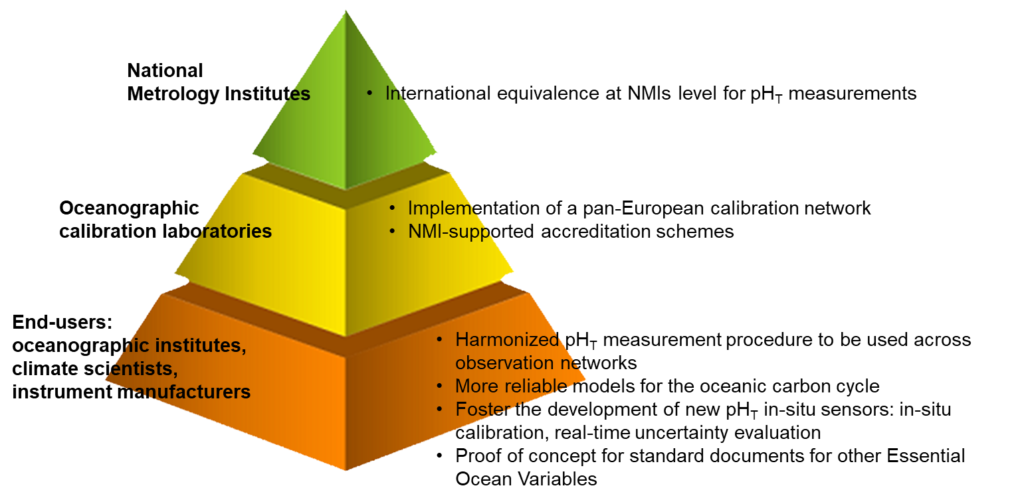

A LNE Joint Research Project


WP Leader: PTB, Germany
Objective: Nowadays, the quantity describing acidity is pH, the international definition of pH being “the negative logarithm (base 10) of the hydrogen ion activity in solution”. Traceability of pH measurement is realised by the use of the Harned cell (a potentiometric, primary method) which is able to provide an expanded uncertainty of 0.003 for the pH value of primary pH buffer solutions, as demonstrated by several Calibration and measurement capabilities (CMCs) at BIPM (Bureau International des Poids et Mesures) level. Similarly, small uncertainties have been achieved in a former European Metrology Research Programme (EMRP) project (ENV05) for the pH value of artificial seawater (ASW) at salinity 35, that can be used as a reference material for seawater pH measurements. Oceanographers, however, prefer to measure pH on the total scale, noted pHT, i.e. the negative log of the total H+ concentration, with spectrophotometric methods, since it has better measurement reproducibility compared to potentiometric methods.
Even though ASW is also used as a primary reference material for pHT measurements of seawater there is currently no agreed, comprehensive measurement model available that links the optical signals of spectrophotometric pHT measurements of seawater (mathematically) to the potentiometric signals of primary pH values of ASW, considering all involved measured quantities and, in particular, their respective traceability.
Main Goals and Key Outputs:
The aim of WP1 is to establish a metrologically sound traceability chain of pHT measurement of seawater to the SI and agreed primary standards. To achieve this goal, sound measurement models will be established that fully consider the potential traceability chain. This will include:
WP Leader: LNE, France
Objective: A key goal for the observation of ocean acidification is to ensure that the measurements made are of appropriate quality for their intended purpose. Fitness for purpose therefore refers to the magnitude of the uncertainty associated with a measurement in relation to the needs of the application area. The experts of the Global Ocean Acidification Observing Network (GOA-ON) have defined different ocean acidification water quality objectives. A “weather goal” and “climate goal” have been set that are differentiated by the level of uncertainty requirements. Thereby, a level of measurement uncertainty of 0.02 (k = 1) is associated with the “weather goal” and considered necessary to identify relative spatial patterns and short-term variation. A measurement uncertainty level of 0.003 (k = 1) is needed to support detection of long-term (multi-decadal timescales) trends enabling to address “climate goal” challenges. The marine chemistry community has rarely attempted to estimate the combined standard uncertainty for the spectrophotometric pHT method, instead usually providing uncertainties estimated based on measurement repeatability.
Main Goals and Key Outputs:
WP2 will produce a complete uncertainty budget for pHT spectrophotometric measurements. . Measurement uncertainty is a metrological concept to quantify the variability of measurement results. Measurement uncertainty can be estimated by two different approaches, each of them being addressed in this workpackage:
Uncertainty evaluation will provide information to assess whether the method proposed in ISO 18191:2015 standard meets the “climate goal” requirements defined by GOA-ON i.e. an uncertainty of 0.003 (k = 1).
WP Leader: Ifremer, France
Objective: Nearshore and estuarine environments play a vital role in the cycling of carbon, but the effects of ocean acidification in estuarine waters have not been studied as extensively as in the open ocean. One reason for this is the limitation of pHT measurement capabilities in low-salinity waters. Spectrophotometric pHT measurements made in brackish waters present challenges not encountered for measurements in the open ocean: (i) lack of characterisation for purified indicator dye for practical salinity below 20, (ii) missing methods to quantify indicator dye perturbation effects (indicator dye itself is an acid-base species), (iii) poor consistency between experimental and calculated pHT values using carbonic acid dissociation constants.
Furthermore, validation of the entire pHT measurement procedure is realised by combining TRIS standard buffer measurements with an estimation of the system inaccuracies with natural seawater reference materials characterised in terms of total alkalinity (TA) and Dissolved Inorganic Carbon (DIC).
Main Goals and Key Outputs:
The aim of WP3 is to apply the results and protocols issued from WP1 and WP2 to validate the capacity of the improved spectrophotometric pHT method to meet the needs necessary for the quantification of ocean acidification and the capacity of laboratories to apply these new recommendations. The target pHT uncertainty is 0.003 (k = 1).
WP Leader: SYKE, Finland
Objective: The aim of this work package is to ensure that the project meets the needs of the oceanographers to observe and capture the variability in ocean acidity for climate change purposes.
The impact on the metrological communities will be provided at different levels of the traceability pyramid.

A continuous flow of information will be ensured to a broader stakeholder community, but also from the stakeholder community to the project team. Dissemination activities will be undertaken to maximise the effect of impact of the scientific and technical results obtained within this project.
We will keep you updated with information about the different events organized during the project lifetime in “News” section.